Email Petition Drive for a Veterans Affairs Headstone Monument for First Lieutenant Oliver
Jenckes, Rhode Island Regiment (Continental) in the front lawn of the National Constitution
Center in Independence National Historical Park, downtown Philadelphia, Pennsylvania
August 2018
by Daniel M. Popek (Army Brat; Descendant of an enlisted soldier who served six years in Rhode Island's Continental Line)
\
In Association with "Friends of America's Continental Line (Revolutionary War)" Facebook Group
Peter Strzok got over $250,000 on his GoFundMe page. My distant cousin First Lieutenant Oliver Jenckes (Continental),
who sacrificed his life for his country during the American Revolutionary War in February 1782, can't even get an
United States Department of Veterans Affairs Headstone Monument that HE IS LEGALLY ENTITLED TO due to your National
Park Service. This web page is an attempt to correct a historical wrong and hopefully wake Americans out of their
slumber over the fact that numerous known American soldiers died and were buried without monuments at certain historical
sites in the eastern United States during the Revolutionary War [and Civil War].
The Rhode Island Regiment of the American Continental Line (the regular U.S. Army of the Revolutionary War) served with
distinction in the Yorktown, Virginia Campaign in late 1781. After the British Surrender at Yorktown, the large American
Grand Northern Army Detachment under General George Washington marched back to the north. The Rhode Island Regiment was
assigned to Winter Quarters in Philadelphia, Pennsylvania, where George Washington would hold his headquarters until
March 22, 1782. What many Americans don't know is that the American Army paid a large price in lives with the Yorktown
Victory. The great concentration of soldiers at Yorktown had caused an epidemic of sickness in the American Army. The
Rhode Island Regiment was particularly hard hit with sickness, and the unit would leave a trail of its soldiers' bodies from
Williamsburg and Yorktown, Virginia to Trenton, New Jersey and Philadelphia, Pennsylvania. To date, the complacency State of
Rhode Island and Providence Plantations has done nothing to honor these soldiers.
Oliver Whipple Jenckes [also spelled "Jenks" or "Jencks"] was born in Cumberland, Rhode Island in 1749, the son of Jonathan
and Hannah Jenckes (William B. Browne, "Genealogy of the Jenks Family of America," (Concord, New Hampshire: Rumford Press,
1952), 56-57, 107). He enlisted as a Private in 1775 in Captain Jeremiah Olney's Company of Colonel Daniel Hitchcock's
Rhode Island Continental Regiment (from Providence County). In 1776, Oliver served in the same company in Col. Hitchcock's
Regiment and was promoted to Sergeant (Benjamin Cowell, "Spirit of '76 in Rhode Island," 1850, 20, 22). In October 1776,
Oliver was commissioned an Ensign, and he carried the regimental flag of Col. Hitchcock's Regiment through heavy enemy fire
at the Battle of Princeton, New Jersey at a critical moment in the battle (Catherine Williams, "Biography of Revolutionary
Heroes; Containing the Life of Brigadier General William Barton, and also, of Capt. Stephen Olney," 1839, 198-199; Bartlett,
"Records of the State of Rhode Island," Volume 8, 1863, 11).
Oliver Jenckes was promoted to a Second Lieutenant in January 1777 and served in Captain Sylvanus Shaw's Company
in the Second Rhode Island Regiment in 1777, including the Battle of Red Bank, New Jersey in October of that year
(Second Rhode Island Regiment Muster Rolls in NARA Microfilm M246). Captain Shaw was killed in action at the Red
Bank Battle [not one monument at this battlefield identifies the several known Rhode Island KIAs from this battle],
and Lt. William Humphrey was promoted to Captain in June 1778 and assumed command of the company in the segregated,
all-white Second Rhode Island Regiment of 1778. Oliver was promoted to a First Lieutenant during June 1777. In
February 1781, the survivors of the small First Rhode Island Regiment, better known as the "Black Regiment," were
integrated with the larger Second Rhode Island Regiment in New York State. First Lieutenant Oliver Jenckes was
assigned to staff duty in Providence, Rhode Island for all of 1781. In February 1781, Oliver married Bethiah Taylor,
the sister of Providence Chaise-Maker Edward Taylor, who became a deacon in the Providence Congregational Church.
Edward Taylor's house still stands in downtown Providence, Rhode Island next to the First Baptist Church (see picture
below).
First Lieutenant Jenckes brought a supply of clothing from Providence to a small detachment of the Rhode Island
Regiment near West Point, New York in January 1782. This Rhode Island Regiment detachment marched for Philadelphia
in January 1782 and arrived in the city late in the month (Robert Bray and Paul Bushnell (ed.), "Diary of a Common
Soldier in the American Revolution, 1775-1783: Military Journal of Jeremiah Greenman," 1978, 241-242). It was a
bad time to join the main Rhode Island Regiment in Philadelphia as it was suffering at the height of the deadly
sickness epidemic. The main killer was a virulent strain of the smallpox, but other diseases like Putrid Fever
were also prevalent. The Rhode Island Regiment was stationed at the French and Indian War Barracks in the
Northern Liberties. The sick of the regiment were quartered in the Barracks and at the Pennsylvania Hospital
on Eighth Street and Pine Street.
Soon after arriving in Philadelphia, First Lieutenant Jenckes was assigned to the colored Eighth Company
of the integrated Rhode Island Regiment. Oliver Jenckes quickly became sick himself after visiting the
unhealthy soldiers of his company. On February 3, 1782, First Lieutenant Oliver Jenckes died of a fever at the
Barracks in the Northern Liberties. The next day, Lieutenant Jenckes was buried in the "Presbyterian Burying Ground"
after a formal military escort by the healthy soldiers of the Rhode Island Regiment. Unlike the enlisted soldiers of
the regiment, who were unceremoniously buried in the soldier burial pits of the "Potters Field," or modern day
Washington Square, an Officer of the Continental Line who died during the war was given formal military honors.
A large crowd of citizens from Philadelphia attended the funeral of Lt. Jenckes, as the Philadelphians were
thankful and mindful of the Rhode Island Continental soldiers' performance at the Battle of Red Bank in 1777
(see the "Pennsylvania Packet, or the General Advertiser" newspaper of February 5, 1782, which the National
Park Service didn't bother to look for in their federally required studies of the National Constitution Center).
Editors Robert Bray and Paul Bushnell of the "Military Journal of Jeremiah Greenman" surmised that the Second
Presbyterian Church Cemetery on Arch Street was the place of burial for Lt. Jenckes, although there were three
other Presbyterian cemeteries in the city at the time. Bray and Bushnell can be shown to be correct, as the
Reverend James Sproat's Journal in the Manuscript Collections of the Pennsylvania Historical Society Library
in Philadelphia records the Reverend's leading the funeral service (James Sproat was the Pastor of the Second
Presbyterian Church on Arch Street; of course, the National Park Service historians also did not check this source).
The integrated Rhode Island Regiment maintained permanent guard details at the Philadelphia Barracks, the
Philadelphia Powder Magazine, the new Stone Jail on Walnut Street adjacent to the "Potter's Field," and later
a guard at the Flag of Truce site on the Philadelphia Waterfront. Several more enlisted soldiers continued to
die in Philadelphia until July 1782. On May 29, 1782 the integrated Rhode Island Regiment marched from Philadelphia
for the last time in the War to the Grand American Northern Army in the West Point, New York area ("Journal of
Jeremiah Greenman," 250).
The death of First Lieutenant Oliver Jenckes certainly effected his family. He left a widow, Bethiah, aged 30, who
never remarried and remained his widow for the rest of her life. To date, no evidence has been found that Oliver
and Bethiah had any children. Bethiah lived with her brother Deacon Edward Taylor at his house in Providence,
Rhode Island until her death on December 9, 1810. She was originally buried in the Congregational Church Cemetery
in Providence, Rhode Island, but this cemetery was relocated to Swan Point Cemetery in eastern Providence. Oliver
also had several siblings: David Jenckes, Jeremiah Jenckes, Asa Jenckes, Mary Jenckes, Amos Jenckes, Nathaniel Jenckes
Hannah Jenckes, Aime (Anne) Jenckes, and Jonathan Jenckes (Browne, "The Jenks Family of America," 56-57). Brother
Jeremiah Jenckes (1739-1810) served in the New Hampshire Militia in the Revolutionary War. Brother Amos Jenckes
(1746-1825) served as a Lieutenant in Colonel Daniel Hitchcock's Continental Regiment in 1775 before moving to
New York State (Ibid., 103-107). There are likely several living descendants of these Jenckes Families alive today.
There are thousands of living Jenckes Cousins, including this web page's author. It is time we made our voices heard!
Modern Issues on Federal Public Land and City Property in Philadelphia
The Second Presbyterian Church Cemetery in Philadelphia continued to be used as an active cemetery until
1867. The State of Rhode Island and Providence Plantations, with a long history of neglecting its Revolutionary
War dead, never bothered to erect a memorial stone to Lieutenant Jenckes or the 65 enlisted soldiers of the
Rhode Island Regiment who were buried in Washington Square. The Presbyterian Church cemetery measured
52 feet by 306 feet for a total of 15,912 square feet. According to the National Park Service, there
were at least 3,654 burials in the cemetery (Anna Coxe Toogood, January 2004, "Historic Resource Study
Independence Mall The 18th Century Block Three Arch to Race, Fifth to Sixth Streets" (available online at:
https://www.nps.gov/parkhistory/online_books/inde/hrs/hrs.htm ;
specifically "Presbyterian Burial Ground" at: https://www.nps.gov/parkhistory/online_books/inde/hrs/hrs3b.htm ).
Burials were removed to at least FIVE other cemeteries beginning in the 1850s. By 1869, all burials were thought
to have been removed (Ibid.). In the late 1800s and early 1900s, other buildings were built in "Block Three," but
several areas in the block did not have basements. In the 1950s, the National Park Service acquired the land
for the Independence National Historical Park. Authorized by the U.S. Congress, construction of the National
Constitution Center began on September 17, 2000 in Block Three. During excavation of the deep foundation of
the new National Constitution Center (a parking garage exists under the building), 150 eighteenth century bodies
were discovered and excavated by the National Park Service Archaeological Staff from Independence N.H.P.
According to head N.P.S. Archaeologist Jed Levin, none of the bodies were found with military artifacts.
First Lieutenant Jenckes should have been buried with his officer's sword, possibly a pistol, and other
military artifacts. The uniform buttons of the Rhode Island Regiment are distinct, and in fact, a soldier
of the Rhode Island Regiment was found in the 1930s at the Colonial Williamsburg site based on these military buttons;
this enlisted soldier was identified a few years ago by myself (see Don Troiani, "Military Buttons of the American
Revolution," 2001, 140, for a discussion of the Rhode Island military buttons). The National Park Service has
refused all requests for copies of the BioArchaeology Report by Dr. Thomas Crist, photographs of the excavated
bodies, maps of the body excavations, and descriptions of all artifacts found with the bodies. Here we have another
Federal Agency that spends lots of taxpayers money, but chooses to hide information that belongs to "We the People."
With only one third of the Second Presbyterian Cemetery excavated professionally by N.P.S. Archaeologists, N.P.S.
historian Anna Toogood concluded, The General State [Pennsylvania] Authority s Plan of Buildings to be
Demolished completed in 1958 for Block 3 showed the two Arch Street lots filled with buildings, but a large
area under the backbuildings had no basements. As no archaeology was necessary for this area (since the
National Constitution Center did not plan construction there), it is not known whether a similar incident
of burial ground vestiges [human remains] remain behind under ground. Very likely there are, based on the
findings at the north and east sides of the burial plot [BOLD for emphasis]. (available online at:
https://www.nps.gov/parkhistory/online_books/inde/hrs/hrs3b.htm ).
Anna Toogood continued: Of the 3,654 burials recorded as of 1851, only 1,479 went to Mount Vernon cemetery,
leaving over 2000 [known burials] unaccounted for at this date. Some of that 2000-odd were moved by prominent
families to other grounds, but some bodies likely remain buried on this block [BOLD for emphasis]. (note 169,
available online at: https://www.nps.gov/parkhistory/online_books/inde/hrs/hrsn.htm#3169 ).
Professional archaeological excavation would be the only way to recover any other remains within the bounds
of the original Second Presbyterian Cemetery. The National Park Service has no plans to conduct any such
excavations. In lieu of an excavation, I proposed to the National Park Service several years ago that a United States
Department of Veteran Affairs Memorial Stone be erected within the bounds of the Second Presbyterian Cemetery
in honor of First Lieutenant Oliver Jenckes. As can be seen in the photos on this page, there is plenty of open
space in the front lawn of the National Constitution Center for the small official three foot high memorial stone
offered by the U.S. Department of Veterans Affairs. The Honorable James Langevin, U.S. Representative from
Rhode Island, conducted an initial investigation of the matter. The results were that the U.S. Department of
Veterans Affairs has agreed to issue a memorial stone, but the National Park Service Management Staff continues
to decline erecting the marker on federal property owned by "We the People." The Rhode Island Congressional
Delegation, representing a State that doesn't even have an official State Monument in Valley Forge National
Park, has taken no other action in this matter. So here we have two federal government agencies which can't
cooperate on federal property. Is it any wonder that Americans are tired of bureaucratic nonsense like this?
Very few Rhode Islanders even know that we have identified Revolutionary War soldiers buried in downtown Philadelphia.
However, the National Park Service I.N.H.P. had other issues to deal with and demonstrated additional incompetence
in the management of our park. The President's House Site in Independence National Historical Park was
the most recent fiasco for the National Park Service. After getting three new buildings in Independence Park,
specifically the Liberty Bell Center, the Independence Visitor Center, and the National Constitution Center,
the Park Service was faced with the dilemma of how to interpret the former President's House site at the north end
of the Liberty Bell Center. After it was learned that some slaves lived in President George Washington's House
(the former Robert Morris House) during his stay in Philadelphia, African American activist groups hammered the
National Park Service in its proposed interpretation of the site. Architectural Historian Edward Lawler Jr., an
independent researcher, blasted the National Park Service's "scholarship" in his two, now-famous articles published
in the "Pennsylvania Magazine of History and Biography:" Edward Lawler Jr., The President s House in Philadelphia:
The Rediscovery of a Lost Landmark, Pennsylvania Magazine of History and Biography, Vol. 126, No. 1, (January 2002),
5-95; and Edward Lawler Jr., The President s House Revisited, Pennsylvania Magazine of History and Biography,
Vol. 129, No. 4, (October 2005), 371-410 (both available online on the Penn State University Digital Library Website:
https://journals.psu.edu/pmhb). As documented in these articles, the National Park Service's treatment of Edward
Lawler Jr. was petty, boorish, and unprofessional. It is high time the U.S. Congress and President Trump clean house
at the National Park Service, particularly with the management staff.
"Avenging the Ancestors Coalition" ("A.T.A.C.", http://www.avengingtheancestors.com/), an African American activist
group, has maintained constant political pressure since the early 2000s on the National Park Service to interpret
the slaves in President Washington's household in Philadelphia. Philadelphia Politicians also were supportive,
especially the now-incarcerated Chaka Fattah, Congressman in the U.S. House of Representatives. Congressman Fattah secured
$12 million in funding for the President's House Site Interpretation in the I.N.H.P. which was opened on December 15, 2010
(see: http://www.ushistory.org/presidentshouse/index.htm). Perhaps the members of Rhode Island's Congressional Delegation,
who have done nothing for the trail of Rhode Island Continental bodies that were left behind during the war, can learn from
Philadelphia Politicians what "Initiative" and "Leadership" mean. At the Opening Ceremony of the President's House Site
Interpretation on December 15, 2010, virtually no one in attendance knew that a mere two blocks to the south lie the remains
of over 30 colored soldiers of the integrated Rhode Island Regiment who were buried there from 1781 to 1782.
With little Congressional Oversight, the "Wheeling and Dealing" National Park Service marches to its own beat.
In 2010, the Independence National Historical Park closed the popular Living History Museum in downtown Philadelphia,
particularly well-liked by Philadelphia school groups, and traded away OUR federal property [now the new Museum of
the American Revolution] for some private acreage in Valley Forge National Park. The Living History Museum housed many
of the archaeological artifacts excavated from the National Constitution Center, and was closed to the public for two years.
Where is the oversight of the National Park Service?
Email Petition Campaign for a Presidential Executive Order for a U.S. Department of Veterans Affairs Headstone
Monument for First Lieutenant Oliver Jenckes
Arguments for a Veterans Headstone Monument for Lieutenant Jenckes
1. Precedence and Historical Value - Lieutenant Jenckes died in 1782 during the American Revolution. There are numerous historical
monuments in downtown Philadelphia and another marker won't hurt.
2. I acknowledge several bodies were removed from this plot of land, but these remains were taken to FIVE different
cemeteries. What are we supposed to do, roll a five-sided dice to determine the cemetery to put the monument in?
3. As the excavation from years 2000 to 2003 of 150 eighteenth century bodies by the National Park Service showed, THERE ARE STILL
BODIES IN THIS PLOT. The installation of a Veterans Headstone Monument would remind Visitors of the fact that numerous American
soldiers died to protect the writers of the U.S. Constitution. I can prove Lieutenant Jenckes was buried in this cemetery, but the
National Park Service CANNOT prove that his body was removed from this plot.
4. While one overpaid Independence National Historical Park Manager informed me that the National Park Service "National Management Plan"
forbids them from erecting a monument, the same Plan directs the National Park Service to cooperate with other U.S. Federal Agencies.
Is the National Park Service cooperating with the U.S. Department of Veterans Affairs here?
5. There is plenty of open space in the front lawn of the National Constitution Center to install a Veterans Headstone monument. The
National Park Service should embed the monument in new concrete and design a protective plastic cover for the monument to be removed at
sunrise and replaced at sunset. The National Park Service has its own dedicated Engineering Department.
6. First Lieutenant Oliver Jenckes IS LEGALLY ENTITLED TO A U.S. DEPARTMENT OF VETERANS AFFAIRS HEADSTONE MONUMENT because he died in an
American war on active duty. Everyone from the American military community understands this concept. Enough of this National Park Service
Federal Bureaucratic Nonsense and outright DISRESPECT to an American Hero!
I wrote an official petition to President Donald Trump in August 2018 asking for a Presidential Executive Order to install a U.S.
Department of Veterans Affairs Headstone Monument within the bounds of the original Second Presbyterian Cemetery in front of the
National Constitution Center fronting Arch Street in downtown Philadelphia. If you agree with me that First Lieutenant Oliver Jenckes
should get the Headstone Monument that he is already LEGALLY ENTITLED TO, please go to the White House email website:
https://www.whitehouse.gov/contact/
Fill out your name, address, rank and military unit if active duty or retired, and write a short note to President Trump, something like:
I, John Smith, of the Aquidneck Island Chapter of the SAR, support a Presidential Executive Order for the installation of a U.S.
Department of Veterans Affairs Headstone Monument for First Lieutenant Oliver Jenckes in the front lawn of the National Constitution
Center fronting Arch Street in Independence National Historical Park in Philadelphia, Pennsylvania.
Heroes like First Lieutenant Jenckes who sacrificed their lives for America during the War of the Revolution should be given top priority
on our American Public Property.
The more emails of support that are sent, the more likely the President will act on the matter. Thanks for your time and please forward
this web page link to any interested friends.
My Proposal for a Rhode Island State Monument in Washington Square and How You the Reader can Help
The Washington Square site is owned legally by the City of Philadelphia, but it is administered as part of the
Independence National Historical Park by the National Park Service. I propose that a stone monument be authorized,
funded, and initiated by local Philadelphia Politicians [because the State of Rhode Island doesn't seem to care] in
Washington Square for the enlisted colored and white soldiers who sacrificed their lives for all Americans. The monument
should list all of our soldiers names, discuss the history of the Rhode Island Continental Line, and remember the costly
post-Yorktown sickness epidemic that took so many of our Rhode Island soldiers' lives (over 100 soldiers of the Rhode
Island Regiment died from sickness after Yorktown, 66 of whom are buried in Philadelphia). In addition, a U.S. Department
of Veterans Affairs memorial stone should be erected in Washington Square for French and American Army Major William de Galvan,
who committed suicide on July 24, 1782 and was buried the next day in the "Potter's Field" (see "Diary of Jacob Hiltzheimer of
Philadelphia," 1893, 50). Major William de Galvan was particularly active at the Battle of Green Springs, Virginia, which
the Light Infantry Company of the Rhode Island Regiment also participated in.
You, the reader, can help by sending letters or emails of support to the following Political Leaders and Groups:
The Independence Hall Association in Philadelphia: http://www.ushistory.org/contact.htm .
Avenging the Ancestors Coalition: http://www.avengingtheancestors.com/ or: ATAC.AvengingTheAncestors@gmail.com
Philadelphia Congressmen [Again, Rhode Island's Congressional Delegation have proven to be useless]:
U.S. Representative Brendan Boyle: https://boyle.house.gov/
U.S. Representative Dwight Evans: https://evans.house.gov/
Some Photos and Maps of Interest from Philadelphia (all landscape photos are copyright of Daniel M. Popek)
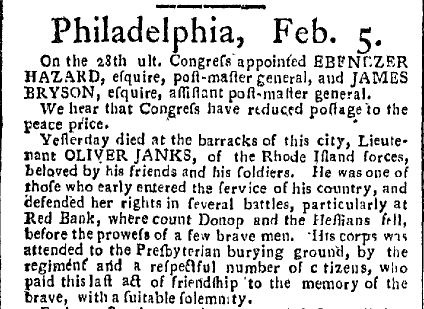
The death notice for Lieutenant Jenckes in the Pennsylvania Packet newspaper
of February 5, 1782. The Philadelphia printer spelled Lieutenant Jenckes'
name wrong.

This was the death notice that was published in the February 23, 1782
Providence Gazette newspaper in northern Rhode Island. Notice that
printer John Carter got the name right.

Black and White Photograph of Grave of Bethiah (Taylor) Jenckes, Widow of First Lieutenant Oliver Jenckes, in Congregational Church Section of Swan Point Cemetery
in Providence, Rhode Island.

The Graves of Deacon Edward Taylor, Chaise-Maker of Providence, R.I., and his wife Alice in Swan Point Cemetery next to grave of Bethiah (Taylor) Jenckes.
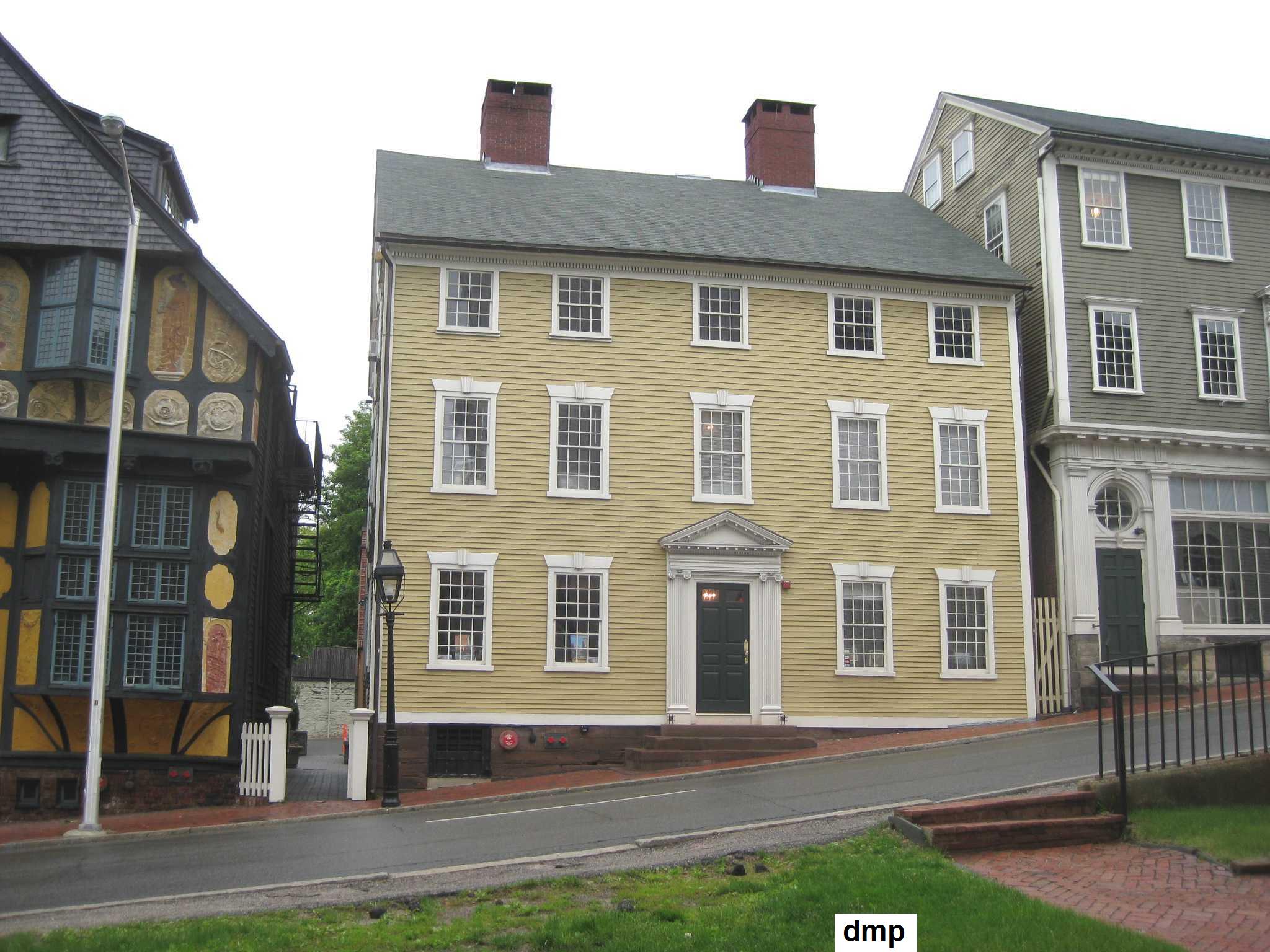
May 2011 View of Deacon Edward Taylor House on Thomas Street next to the First Baptist Church in downtown Providence, Rhode Island.
Lieutenant Jenckes' widow Bethiah (Taylor) Jenckes [1752 - 1810] lived at this house with her brother's family for the rest of her life.
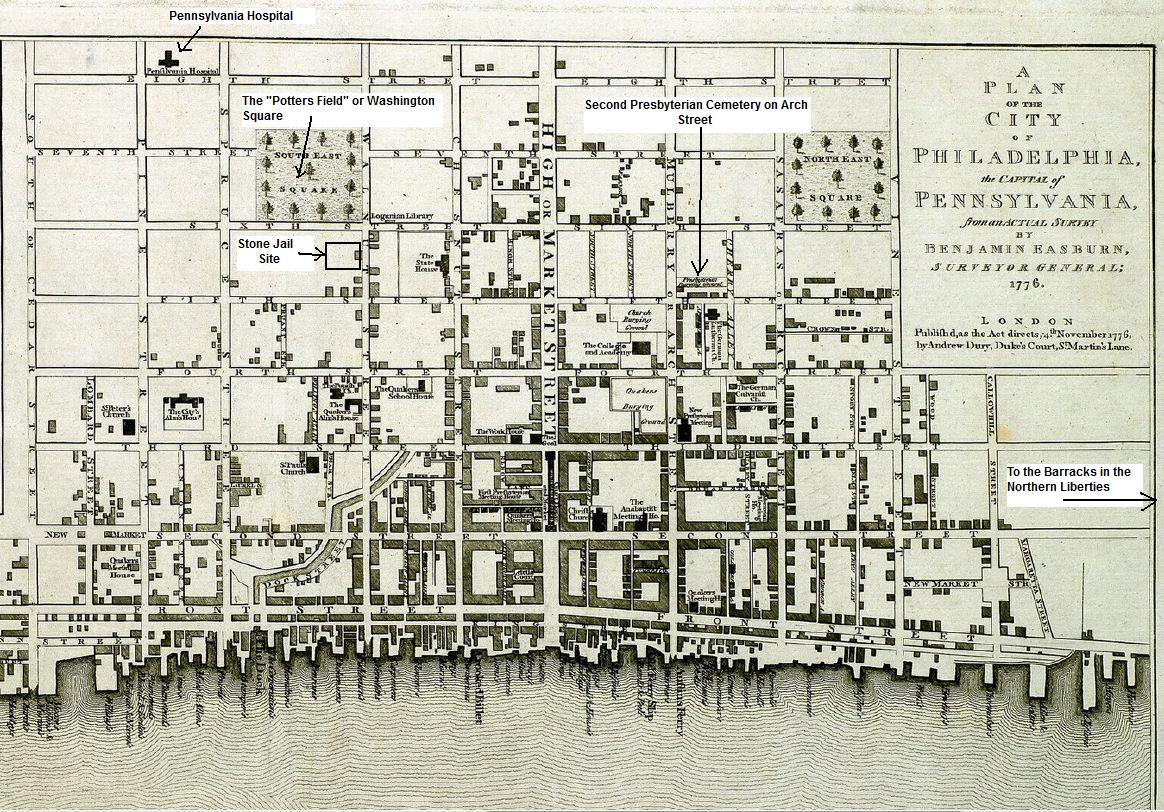
Benjamin Easburn's 1776 Map of Philadelphia (courtesy of Library of Congress, Geography and Maps Division) with sites important
to the Rhode Island Regiment. The R.I.R. was quartered at the Barracks in the Northern Liberties.

Map of Modern Independence National Historical Park (courtesy of National Park Service) in downtown Philadelphia with sites important
to the Rhode Island Regiment. The Second Presbyterian Church Site is shown in front of the National Constitution Center.

Map of the Archaeological Excavation done under the footprint of the National Constitution Center, 2000-2003, from the now-defunct N.P.S.
Living History Museum in Philadelphia. This map is the only one that I have been able to find as the National Park Service is deliberately
hiding all information concerning the 150 bodies that were removed from 2000 to 2003. Note that only the northern one third of the Second
Presbyterian Cemetery was excavated which resulted in 150 bodies from the 18th Century. The National Park Service admits that a number of
human bodies likely remain in the area to the south of the excavation line.
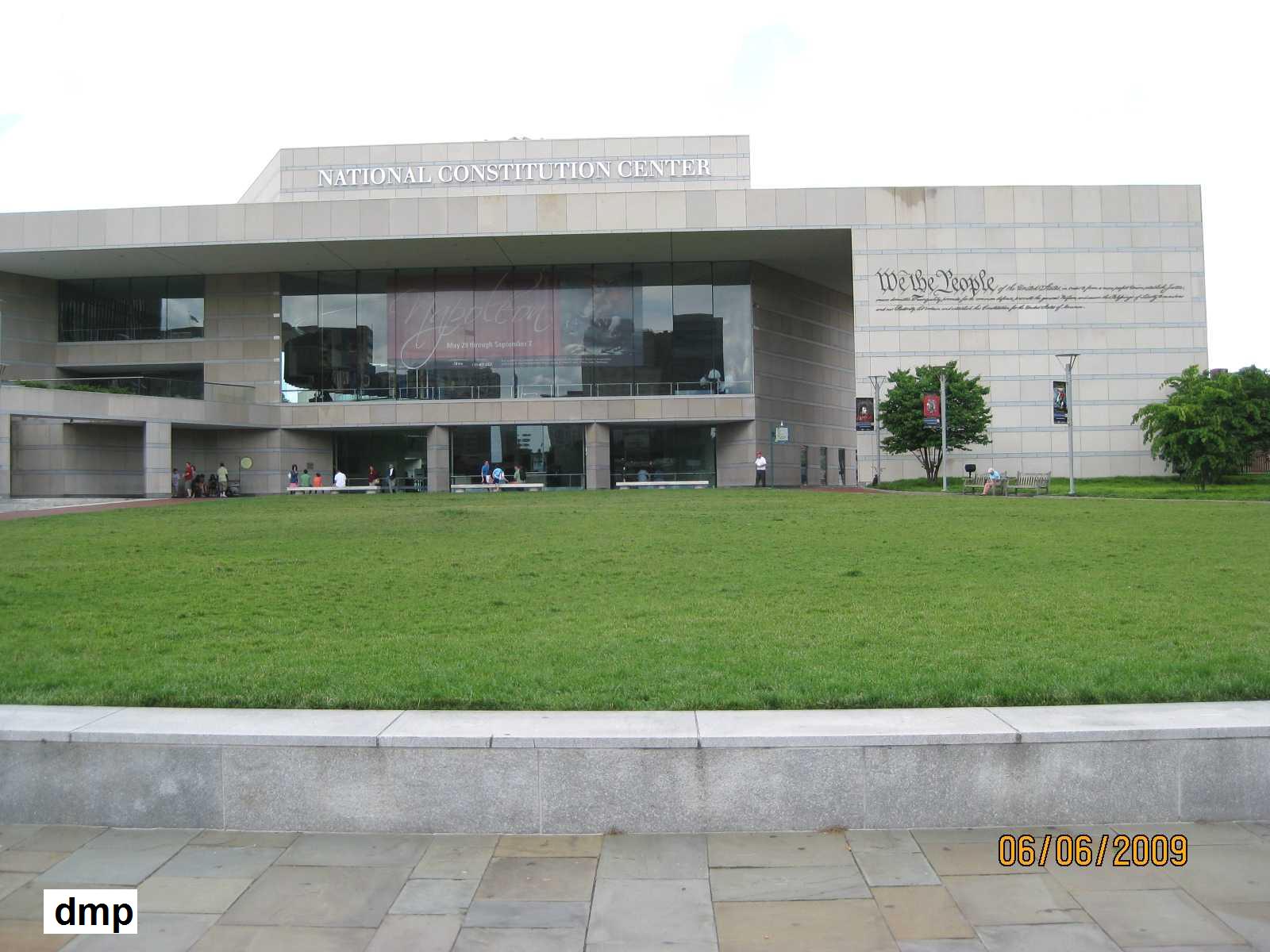
June 2009 view of the National Constitution Center in downtown Philadelphia from Arch Street.
The path on the right side that leads to the entrance goes over the former Second Presbyterian Church Burial Ground.
During construction of the deep foundations of the National Constitution Center, about 150 Eighteenth Century bodies
were recovered and removed in the year 2000 by the National Park Service. An unknown number of bodies likely remain
under the front lawn in this picture, possibly including the remains of First Lieutenant Oliver Jenckes of the R.I.R.
Note the "We the People" pier on the right. The National Park Service hid the small interpretive plaques about the
Second Presbyterian Church Cemetery on the back side of the "We the People" pier. Most Visitors never see these
plaques and realize that there was a cemetery here.

View from the front entrance of the National Constitution Center south towards Arch Street. The curving path, which
goes directly over the old Presbyterian Cemetery, leads to the Quaker Meeting House that was constructed in 1783.

One of the small interpretive plaques on the back side of the "We the People" pier.
Most Visitors to the National Constitution Center never notice these plaques.

View of Construction of the President's House Site Interpretation in November 2009.
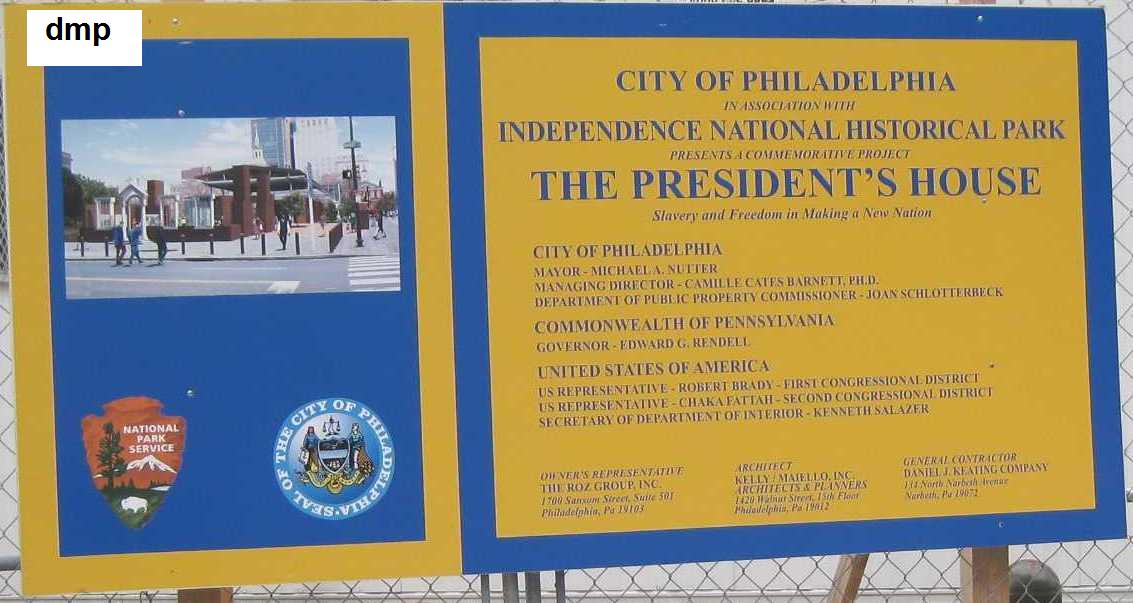
Construction Sign at the President's House Site Interpretation in November 2009.

September 2011 View of the finished product, the President's House Site, opened in December 2010 in downtown Philadelphia.

September 2011 side view of President's House Site on Market Street in downtown Philadelphia. There are several
interpretive signs of African-American History in Philadelphia on the walls of the President's House Site.

September 2011 side view of President's House Site in Philadelphia. The Liberty Bell Center on Block 1 is to the left,
while Market Street and the Independence Visitor Center on Block 2 is to the right.

The Slaves in President George Washington's household in Philadelphia.
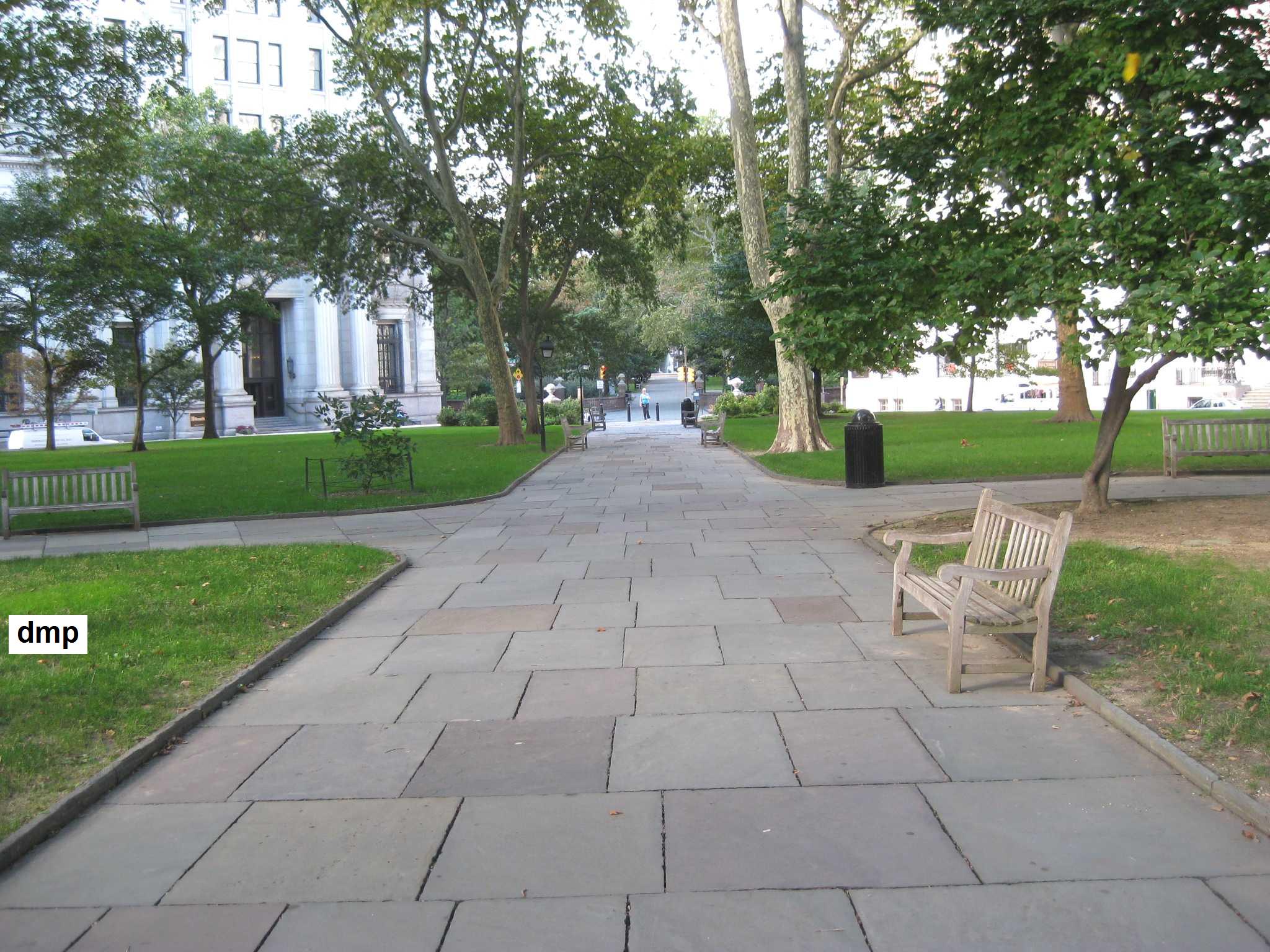
"Buried and Forgotten:" View from the Plaza south of Independence Hall to the northeast corner of Washington Square.
The building to the left is where the old Stone Jail stood. The Rhode Island Regiment maintained a permanent guard detail
here while they were stationed in Philadelphia from late 1781 to 1782. The entrance to Washington Square, where the woman
is standing in the above picture, leads to the final resting place of over 2000 American soldiers. A mere two blocks from
the President's House Site, Washington Square contains the remains of 65 known enlisted Rhode Island Regiment soldiers, about
half of whom were men of color. Another Rhode Island Continental Officer, Ensign Daniel Greene, who was a Prisoner of War
of the British after the Red Bank Battle, died about April 30, 1778 and likely was buried here. Major William de Galvan of
France who served in the American Army is also buried in an unmarked grave in the Square.

November 2018 Letter from the Trump White House to myself. A Presidential Executive Order is what we need, so keep sending in your emails of
support for a Presidential Executive Order for a proper monument for First Lieutenant Oliver Jenckes.
Click on picture for a larger view.

The December 2018 letter from National Park Service Northeast Regional Director Ms. Gay E. Vietzke to myself giving more lame excuses why our
National Park Service can't do the right thing, and why they need a Presidential Executive Order forcing them to actually serve the American Public.
Before I refute this joke of a letter, some background on Ms. Gay E. Vietzke, who makes a minimum of $167,000 per year: she has a Bachelor of Arts
degree in Art History from the University of Connecticut. Now, let's refute this letter in detail. First, I am a distant cousin of First Lieutenant
Oliver Jenckes and not a descendant. Lieutenant Jenckes' untimely death on active duty in service of his country cost him and his surviving widow any
chance of having children, while National Park Service Bureaucrats like Ms. Vietzke, who wouldn't even have their current jobs if it weren't for Lt. Jenckes'
sacrifice, rake in huge salaries off my Federal Taxes. "The park is neither a national cemetery..." But it does have an actual historic cemetery in the
front lawn of the National Constitution Center as the body snatchers of the National Park Service proved when they yanked 150 18th century human remains
out of the northern one third of the original Second Presbyterian Church Cemetery during construction of the Constitution Center foundation in the year 2000.
The National Park Service didn't ask my permission (or any other American Taxpayers for that matter) to remove these bodies, nor did they get my permission
to trade We the People's Land in Philadelphia (which is now the National Museum of the American Revolution) for land in Valley Forge. Washington Square is
actually owned by the City of Philadelphia, not the National Park Service. What the heck is National Park Service "Stewardship"? Their mismanagement of the
Presidential House Site in Philadelphia is now well-known in that city. According to the National Park Service National Management Plan, the National Park
Service is supposed to cooperate with other Federal Agencies. What overpaid National Park Service Bureaucrats like Ms. Vietzke have no understanding of is
that EVERY AMERICAN SOLDIER WHO DIES ON ACTIVE DUTY IS LEGALLY ENTITLED TO A U.S. DEPARTMENT OF VETERANS AFFAIRS MONUMENT.
Quite clearly, the National Park Service is NOT cooperating with the U.S. Department of Veterans Affairs here. The most obvious argument for a monument
for First Lieutenant Oliver Jenckes is precedence. First Lieutenant Oliver Jenckes was buried in this plot of land in 1782, well before our bungling National
Park Service was even created. The Deep State doesn't just exist in the U.S. Department of Justice. The National Park Service Management has more than its
share of overpaid Deep State hacks that appear to be accountable to no one (certainly not the U.S. Taxpayer).
SOURCES
Daniel M. Popek, They "...fought bravely, but were unfortunate...," The True Story of Rhode Island's
"Black Regiment" and the Failure of Segregation in Rhode Island's Continental Line, 1777 - 1783, AuthorHouse, 2015.
[my own book which covers the colored and white soldiers of Rhode Island's Continental Line in a balanced and
accurate account]
U.S. National Archives Microfilm M246, "Revolutionary War Rolls, 1775-1783" (Original Muster Rolls - -
Rhode Island Regiments).
Revolutionary War Transcription File Index, Rhode Island State Archives, Providence, Rhode Island.
Benjamin Cowell, "Spirit of '76 in Rhode Island: or Sketches of the Efforts of the Government and
People in the War of the Revolution" (Boston: A. J. Wright (Printer), 1850).
Website: "Rhode Island Historical Society Library Manuscripts Division: Revolutionary War Military Records:"
http://www.rihs.org/mssinv/Mss673sg2.htm
Born in Providence, Rhode Island, Daniel M. Popek is a descendant through his mother's family of a soldier who served
six years in Rhode Island's Continental Line, including the integrated Rhode Island Regiment (Continental) of 1781-1783.
Daniel lives and works in North Carolina. He is a member of the Rhode Island Genealogical Society, and the New England
Historic Genealogical Society of Boston, Massachusetts. Daniel is the son of a career Active Duty U.S. Army Officer (Retired),
and the grandson of a U.S. Marine Combat Infantryman of World War II (Third Marine Division).
If you have comments or can provide additional information on any historical or archaeological issues,
then please send me (Dan) an email.









